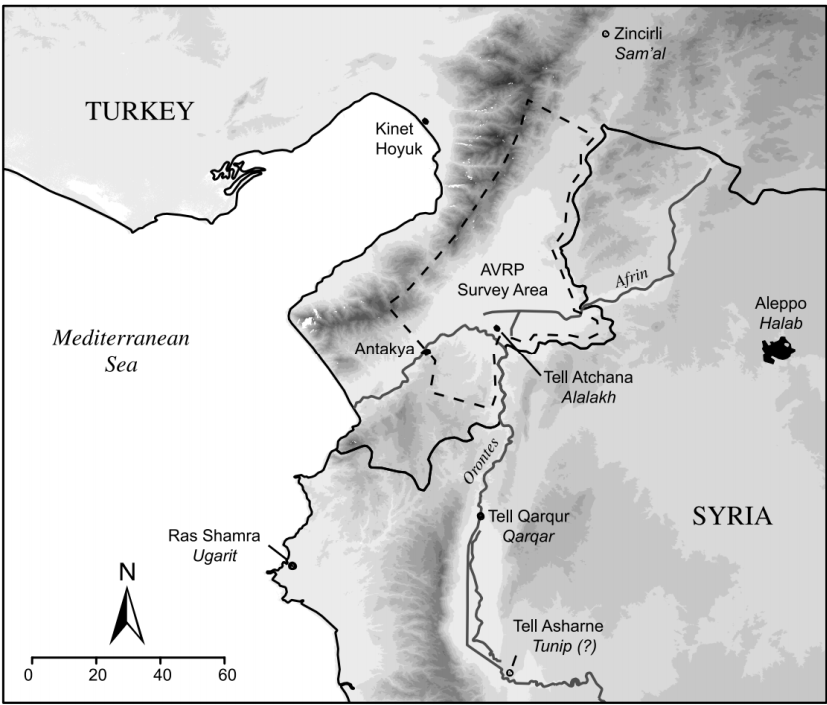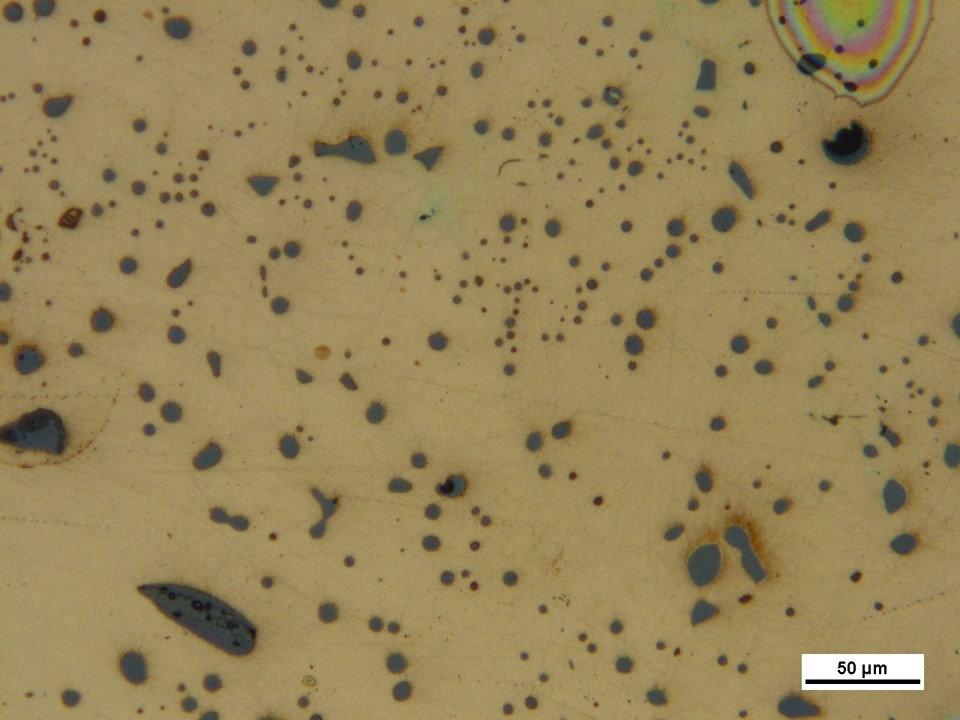Investigation of Archeological Slag
Kathleen Dewan and Kristen Scotti
in collaboration with Prof. Marc Walton, Center for Scientific Studies in the Arts
Tell Atchana ("Alalakh") is an ancient city located near a major branch of the Asi river in the Amuq Valley in southern Turkey (Fig. 1). Alalakh was occupied from the late-Early Bronze Age into the Iron Age; excavations led by Prof. Kutlu Aslihan Yener (University of Chicago) which took place from 2003-2012 [1], uncovered craft quarters within this ancient city. The purpose of this work is to investigate slag specimens that were uncovered during the 2003-2006 excavation seasons by Prof. Yener's team for the purpose of reconstructing the life-cycle of these specimens in an effort to better understand the manufacturing processes and sources of raw materials that were used during these time periods Alalakh.
Fig. 2 shows optical micrographs of a crucible fragment that was uncovered during the 2003 excavation season. Yener et al. [1] previously reported XRF data on the crucible charge, which showed peaks for copper, tin, and arsenic. We conducted preliminary XRF analysis on a different area of the crucible charge and detected a peak for iron in addition to a peak for copper as previously detected. We detected copper, iron, and tin via both EDS and XRD analyses, and strontium via XRD. Yener et al. also conducted lead isotope analysis on the crucible charge and compared those data to ore data; they concluded that the copper analyzed originated from the Taurus Mountains. We are in the process of conducting Raman spectroscopy on the ceramic crucible material.
Fig. 3 shows an optical micrograph of a metallographic cross-section taken of a slag specimen that was uncovered during the 2006 excavation season from the so-called "Level IV Palace". Three phases of occupation have been identified within this region and the collection location of this specimen corresponds to local era Late Bronze Age I [1]. This specimen, in particular, was uncovered from a large mudbrick wall and classified by the excavation team as "reused deposit" [3]. Preliminary analysis suggests that off-site anthropogenic soils and rubble may have been used as raw materials for the fabrication of mudbrick tiles [1]. The specimen is primarily copper; we conducted preliminary EDS analysis on the dark spots observed during optical investigation (Fig. 3); elemental mapping showed sulfur and some iron, which may indicate that the copper was produced from a sulfide ore and the dark spots are chalcopyrite particles.
Fig. 4 shows photographs of a vitreous specimen uncovered during the 2003 excavation season. Materials related to pyrotechnical installations were uncovered during Yener's excavations; analyses of these materials suggests that Alalakh may have been a glass making site [4-6]. One side of the specimen has a large, dark brown rough patch (12x15 mm; Fig. 4); with a pattern similar to that described as flow markings in tap slag. The remaining material on that side has a reddish-orange, glassy-appearance with dark-brown veins and spots scattered throughout. Preliminary EDS analysis of these dark-brown regions showed large peaks corresponding to Si, Al, and Ca and smaller peaks corresponding to Fe, Mg, C, and K.
The opposite side of the specimen has a glasslike, fractured-surface appearance (jagged edges) with reddish-orange coloring around the perimeter and a mixture of opaque and translucent glass-like areas in the center. Scattered, reddishorange freckling are scattered over the entire surface with a higher density toward the perimeter. Preliminary EDS analysis of the glassy face of the specimen showed a high peak for Si. Powder X-ray diffraction analysis was conducted using material from the glassy face; these data showed a close match to the diffraction pattern of α-quartz, which has a hexagonal structure. The α-quartz phase that was observed is the low temperature stable form of β-quartz and the phase transformation could be obtained at 573 ℃ at atmospheric pressure. Given the absence of crystalline phases that are characteristic of glass production, such as wollastonite or diopside, we are unable to conclude that this material is related to glass-making. The flow-markings suggest it may be it may be iron slag, but the slow-temperature form of quartz observed makes that unlikely. Further analysis is needed to clarify these questions.

Fig. 1. Map showing the location of Alalakh; extracted [2].

Fig. 2. Optical micrographs showing the microstructure of a crucible specimen that was uncovered in 2003 from an area that contained household assemblages; the top two images show the crucible charge and the bottom two images show the ceramic crucible material.

Fig. 3. Optical micrograph of a metallographic cross-section of a slag specimen that was uncovered during the 2006 excavation.

Fig. 4. Photographs of a vitreous slag specimen uncovered during the 2003 excavation season.
Related Publications
- Yener, K.; Batiuk, S., Tell Atchana, Ancient Alalakh. Koç Üniversitesi Yayinlari: 2010
- Casana, J., Alalakh and the archaeological landscape of Mukish: the political geography and population of a Late Bronze Age kingdom. Bulletin of the American Schools of Oriental Research 2009, 7-37
- Horowitz, M.; Çakirlar, C., Novel Uses of Wild Faunal Resources at Transitional MiddleLate Bronze Age Tell Atchana. Overturning Certainties in Near Eastern Archaeology: A Festschrift in Honor of K. Aslihan Yener 2017, 90, 222.
- Dardeniz, G., Sharing Technologies and Workspaces for Ceramic and Vitrified Material Production at Tell Atchana-Alalakh. Overturning Certainties in Near Eastern Archaeology: A Festschrift in Honor of K. Aslihan Yener 2017, 90, 139
- Casana, J.; Gansell, A., Surface ceramics, off-site survey, and floodplain development at Tell Atchana (Alalakh). The Amuq Valley Regional Projects 2005, 1, 1995-2002.
- Dardeniz, G., The Preliminary Archaeological and Scientific Evidence for Glass Making at Tell Atchana/Alalakh, Hatay (Turkey). Anatolian Archaeological Studies 2018, XXI
